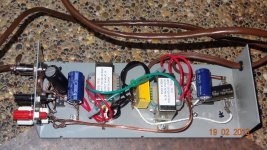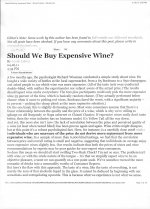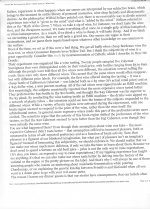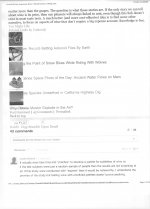Actually, it wasn't even a study. It's a press release. Totally believable: non-experts can certainly tell wine A from wine B, but would also be incapable of telling which was expensive. A lot of experts as well- there's expensive wine out there which is pretty mediocre but is in great demand because of hype and limited supply.
But hey, if you have no coherent argument, why not kick up old dust and hope that no-one remembers?
But hey, if you have no coherent argument, why not kick up old dust and hope that no-one remembers?
Here would be such a deceptive so called double blind test. I have a loudspeaker system that does not change. I have three very expensive amplifiers driving the system and you can not see them or know the names on them. Now I want you to rate them by cost most expensive to least expensive. I would like to see any test like this that would have any real result besides random choice!
I don't understand this story of prices. Of course, famous wines, tasted by experts on the best years are expensive, and a guarantee of quality.
You can be sure there are unknown wines, somewhere in caves of individual or little restaurants, with no commercial value because it is not in the big business but personal products are better. You can even find in French super markets fantastic wines for low prices, because nobody noticed their quality: up to you to make them nicely aging.
You can be sure there are unknown wines, somewhere in caves of individual or little restaurants, with no commercial value because it is not in the big business but personal products are better. You can even find in French super markets fantastic wines for low prices, because nobody noticed their quality: up to you to make them nicely aging.
(*) When I first experimented with the bridging cap some years ago, I was monitoring the 0V rail current and I had seen the improvement there, alas I don’t find records from these tests.
This is interesting stuff, thx. There is the brute force way: Use two transformers and rectifiers and filter caps to make seperate plus and Minus rails. What happens on one rail does not impact the other rail. Ground/common are seperate all the way to the V-reg common point. See attached.
But there are other ways less brutal, I'm sure.
Some things to point out --> Dont trust transfomer VA ratings as they are a competitive rating unless it is to a Standard and they state the standard for their regulation spec. In many cases a larger VA rating will help with regulation. Here I showed a 2A/2A windings and 4A core and only loaded it with 1.5A and the regulation wasnt so hot. Everyone needs to read the fine print on transformers.
Note also that most DC Volt Reg do Not do as well with incoming line-side changes as they do with output load changes. Pay at least as much attention to the Line Reg spec and impovements there will reap benifits as well.
Here I am looking for methods related to keeping the rails of equal value on both sides - line and load with asymetrical changes.
Thx for the interesting SIM data. -RNMarsh
Attachments
Last edited:
RNMarsh,
I know I am not the one to answer your question you are asking here in a technical sense but I have seen designs where there was capacitive coupling between the two sets of windings before the regulators and also after the rectifiers. Is this something that you are speaking of?
I know I am not the one to answer your question you are asking here in a technical sense but I have seen designs where there was capacitive coupling between the two sets of windings before the regulators and also after the rectifiers. Is this something that you are speaking of?
Wine tasting has gotten far more objective in recent years, and for the most part a whole lot less fun. It is hard work, and you cannot imbibe much without skewing your judgments horribly. So not many people really conduct authentic double-blind tastings.
The other well-known effect, supported by brain scans etc., and comparable to the situation regarding loudspeakers to some extent, is that when you can see what you are tasting or hearing your judgments change, usually a lot. If you know something is inexpensive you will tend to downgrade it and doubt your senses.
I took a bottle of good French burgundy to a place once and tore off all but the 99 cent portion of the price tag. No one wanted to even try it. It was very good and a good value, and I drank it happily. Finally I persuaded one person to try it, and he made a face as he sipped it, almost a scowl. "Sure is GRAPE-EY!" "But hey, whatever gets you loaded". OK, so he was relatively unsophisticated. But another person there who was somewhat more knowledgeable was also fooled, and when the first guy left I let him know of the misdirection. At that point he began to be able to enjoy the wine.
The other well-known effect, supported by brain scans etc., and comparable to the situation regarding loudspeakers to some extent, is that when you can see what you are tasting or hearing your judgments change, usually a lot. If you know something is inexpensive you will tend to downgrade it and doubt your senses.
I took a bottle of good French burgundy to a place once and tore off all but the 99 cent portion of the price tag. No one wanted to even try it. It was very good and a good value, and I drank it happily. Finally I persuaded one person to try it, and he made a face as he sipped it, almost a scowl. "Sure is GRAPE-EY!" "But hey, whatever gets you loaded". OK, so he was relatively unsophisticated. But another person there who was somewhat more knowledgeable was also fooled, and when the first guy left I let him know of the misdirection. At that point he began to be able to enjoy the wine.
Another example. Trader Joe's bought some Argentinian Chardonnay recently that had been released for around 8 bucks. A straightforward clean no-oak nothing-to-write-home about wine which I'd be happy to be served in a casual setting.
Critics gave the wine 82 and 83 points, a rating with which I'd concur, maybe even increase slightly.
Then the TJ mass buy hit the streets. One of the next ratings was 72, and the guy said don't bother unless you are happy with two-buck chuck. Now maybe he got a bad bottle, but far more likely is that he was deeply influenced by the price. I would love to slip this wine into a blind tasting. I compared it to a much more expensive chard I had open and the differences, although discernible, were not anywhere near reflective of the ratio of prices (about 9:1). But I am cursed with a tendency to objectivity while all around me people are confused and misdirected.
Critics gave the wine 82 and 83 points, a rating with which I'd concur, maybe even increase slightly.
Then the TJ mass buy hit the streets. One of the next ratings was 72, and the guy said don't bother unless you are happy with two-buck chuck. Now maybe he got a bad bottle, but far more likely is that he was deeply influenced by the price. I would love to slip this wine into a blind tasting. I compared it to a much more expensive chard I had open and the differences, although discernible, were not anywhere near reflective of the ratio of prices (about 9:1). But I am cursed with a tendency to objectivity while all around me people are confused and misdirected.
RNMarsh,
I know I am not the one to answer your question you are asking here in a technical sense but I have seen designs where there was capacitive coupling between the two sets of windings before the regulators and also after the rectifiers. Is this something that you are speaking of?
Maybe -- Not sure. Can you attach any schematics/drawings of what was done as you describe?
Richard I will have to find the schematic. It was in the Gootee thread on capacitor size requirements for a power supply. It was an attempt to balance the separate winding in a center taped winding I think, but I may be incorrect and it was two separate windings without a center tap. So I will have to look and see what I can find of the circuit.
Go for it, I'm a big boy.
Well, your and Dave's thesis is that 1/f noise is the dominant source of noise in audio, and I explained in #35359 why I don't hold that to be true, based on what I saw in measurements and understand from theory. Why don't you engage in a substantial debate on this point? Wine and cheap shots at the usual suspect appear to be always fun for some, but let's dig into a real issue a bit deeper.
The complication in all this is that audio is a game where you are attempting to fool the senses. Otherwise, all you would ever hear are speaker drivers being exercised. Aiming for an absolute of performance may be an excellent tool for getting closer to the goal, but can never verify that the goal has been reached ...I thought one of the basics of all sensory science, including audio, is that senses (and hence experience) are not to be fully trusted. They can easily be fooled. Therefore personal experience is about the worst possible way of learning in this area. It almost guarantees misconception and failure.
Frank
I pulled the article out of my 'pocket', guys. Trust me, I DO believe that there are differences between wine, but some SCIENTISTS don't think so, or at least as much as normally assumed.
Is it a matter of reading comprehension or do you think that if you repeat a lie enough times, it somehow becomes true?
Who says it is a lie, SY? Looks scientific enough for me. Perhaps you can see my perspective on double blind tests in my experience with audio. What should be good enough for the 'goose' (me), should be good enough for the 'gander' (you) '-)
Why call me a liar? I am only quoting others. You know, 'scientists'.
Why call me a liar? I am only quoting others. You know, 'scientists'.
Last edited:
First off, it's a press release, and one that even is flagged as "not fact-checked." Second, it doesn't say ANYWHERE that people couldn't tell wine A from wine B, only that non-experts couldn't classify them by price. I assumed that it was a reading comprehension issue on your part, but now I'm not so sure.
Well, your and Dave's thesis is that 1/f noise is the dominant source of noise in audio, and I explained in #35359 why I don't hold that to be true, based on what I saw in measurements and understand from theory. Why don't you engage in a substantial debate on this point?
Be delighted. I'm rather sickened by the crass intellectual dishonesty shown by some here- real discussion is so much more useful.
I'd start by looking at en plots of active devices. They all have a 1/f corner at audio frequencies. This is not surprising since shot noise is expected to have a 1/f characteristic. Likewise, we see a 1/f corner in any RC-coupled circuit. As well, the excess noise of resistors generally follows 1/f characteristics. These are dominant noise sources in analog audio electronics.
edit: note the noise spectra in this paper: https://dcc.ligo.org/public/0002/T0900200/001/current_noise.pdf
Regarding 1/f noise, I may have been in valve mode when I answered the question. I seem to recall that low noise valves typically have a corner frequency somewhere in the region of 10kHz, so 1/f noise usually dominates valve audio. MOSFETs are higher. JFETs and BJTs are usually much lower - maybe 100Hz-1kHz. There may be other sources of audio 1/f noise apart from active devices. As it is poorly understood, although found everywhere, predicting it is difficult.
Sorry for confusing/misleading anybody.
Sorry for confusing/misleading anybody.
- Status
- Not open for further replies.
- Home
- Member Areas
- The Lounge
- John Curl's Blowtorch preamplifier part II



